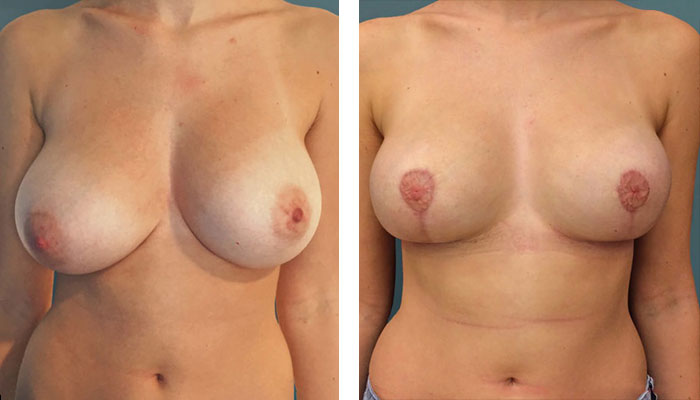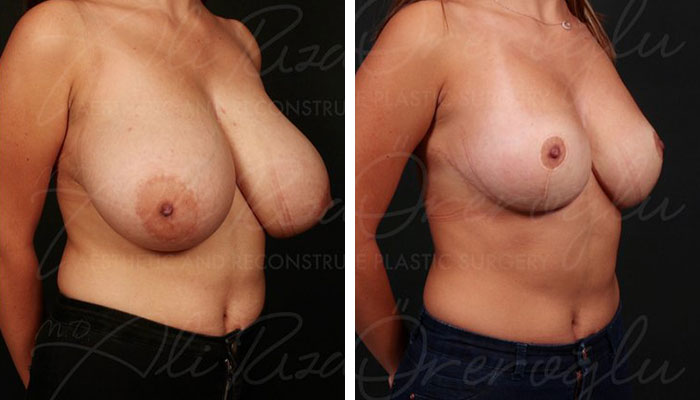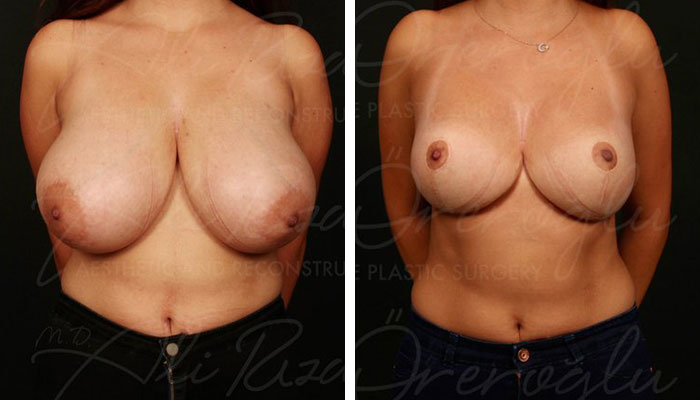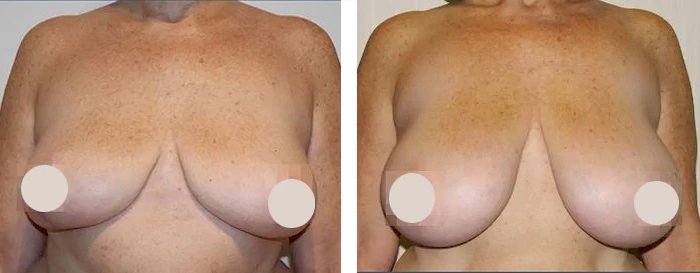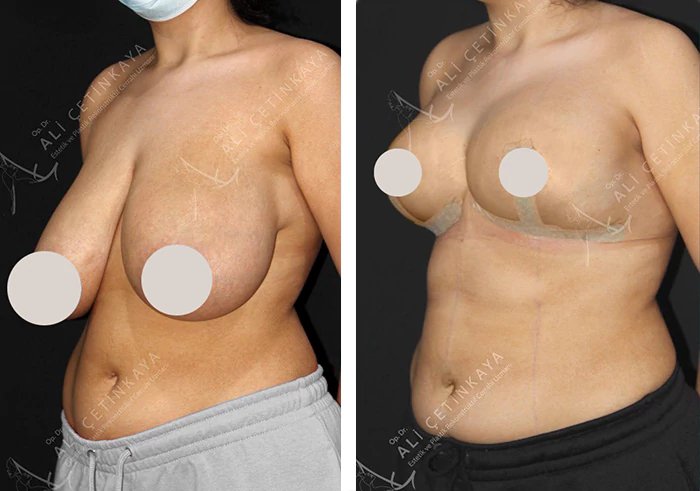What is breast reduction?
Breast reduction, also known as reduction mammoplasty, is a surgical procedure to remove excess breast fat, glandular tissue, and skin to achieve a breast size more proportional to your body. This procedure is often performed to alleviate physical discomfort, such as back or neck pain, caused by overly large breasts. It can also help improve self-image and confidence.
Breast reduction surgery involves making incisions on the breasts to remove excess tissue, fat, and skin. The remaining breast tissue is reshaped and the nipples may be repositioned to create a more aesthetically pleasing appearance. The size of the areola (the darker skin surrounding the nipple) may also be reduced if necessary. The surgery is typically performed under general anesthesia and can take a few hours to complete.
Why do women have breast reduction?
Women opt for breast reduction surgery for various reasons, including:
- Physical discomfort: Large breasts can cause back, neck, and shoulder pain, as well as skin irritation and rashes underneath the breasts. Breast reduction can alleviate these physical symptoms.
- Difficulty in physical activities: Women with large breasts may find it challenging to engage in physical activities or exercise comfortably. Breast reduction can improve mobility and make exercise easier.
- Psychological well-being: Some women may feel self-conscious or have low self-esteem due to the size of their breasts. Breast reduction can help improve body image and self-confidence.
- Proportion and symmetry: Women may opt for breast reduction to achieve a more balanced and proportionate body shape. This can enhance overall aesthetics and clothing fit.
- Medical reasons: In some cases, large breasts can lead to medical issues such as poor posture, skeletal deformities, or difficulty breathing. Breast reduction can address these health concerns.
Ultimately, the decision to undergo breast reduction is a personal one, and it is important for individuals to carefully consider their reasons, consult with a qualified surgeon, and understand the potential risks and benefits of the procedure before moving forward.
Who is a breast reduction suitable for?
Breast reduction surgery may be suitable for individuals who:
- Experience physical discomfort: Those who suffer from chronic pain in the back, neck, and shoulders due to the weight of their breasts may benefit from breast reduction surgery.
- Have disproportionately large breasts: Women with breasts that are significantly larger in proportion to their body frame may consider breast reduction to achieve a more balanced silhouette.
- Face difficulty in daily activities: Individuals who find it challenging to engage in physical activities, exercise, or find well-fitting clothing due to the size of their breasts may opt for reduction surgery.
- Desire improved body image: Those who are unhappy with the appearance of their breasts and seek to enhance their self-confidence and body image may choose reduction mammoplasty.
- Understand the risks and benefits: Candidates must have realistic expectations about the outcomes of the surgery, understand the potential risks involved, and be committed to following post-operative care instructions for optimal results.
Before undergoing breast reduction, individuals should consult with a qualified plastic surgeon to assess their candidacy, discuss their goals and concerns, and determine if the procedure is the right choice for them.
How to prepare for the procedure
To prepare for a breast reduction procedure, consider the following steps:
- Consultation: Schedule a consultation with a board-certified plastic surgeon specializing in breast reduction. Discuss your goals, concerns, medical history, and expectations for the surgery.
- Medical evaluation: Your surgeon may conduct a physical examination, review your medical history, and possibly order pre-operative tests to ensure you are in good health for surgery.
- Quit smoking: If you smoke, it's advisable to quit several weeks before surgery, as smoking can impair healing and increase the risk of complications.
- Medications and supplements: Inform your surgeon about any medications, supplements, or herbal remedies you are taking, as some may need to be adjusted or discontinued before surgery.
- Follow pre-operative instructions: Your surgeon will provide specific guidelines on eating and drinking before surgery, as well as any medications to avoid in the days leading up to the procedure.
- Arrange for help: Plan for someone to drive you to and from the surgery and assist you during the initial days of recovery, as you may experience limited mobility and discomfort.
- Prepare your home: Set up a comfortable recovery area at home with necessary supplies, such as loose-fitting clothing, pillows for support, and prescribed medications.
- Understand the procedure: Educate yourself about the breast reduction procedure, including the risks, benefits, and expected outcomes, to ensure you have realistic expectations.
By following these preparation steps and working closely with your surgeon, you can help ensure a smoother surgical experience and optimize your recovery from breast reduction surgery.
What to expect during the procedure
During a breast reduction procedure, here is what you can generally expect:
- Anesthesia: You will be given anesthesia to ensure you are comfortable and pain-free during the surgery. The type of anesthesia used (general or local with sedation) will be determined by your surgeon.
- Incisions: The surgeon will make incisions on the breasts, typically following a predetermined pattern based on the amount of tissue to be removed and the desired outcome.
- Tissue removal: Excess breast tissue, fat, and skin will be removed through the incisions. The remaining breast tissue will be reshaped and the nipples may be repositioned for a more aesthetically pleasing result.
- Closing incisions: Once the desired breast size and shape are achieved, the incisions will be meticulously closed with sutures. Drainage tubes may be inserted to prevent fluid buildup.
- Recovery: You will be monitored in a recovery area as the effects of anesthesia wear off. Most patients are able to return home the same day, although some may require an overnight stay in the hospital.
- Post-operative care: Your surgeon will provide instructions on caring for your incisions, managing any discomfort, wearing compression garments, and scheduling follow-up appointments.
It's important to communicate openly with your surgical team, follow post-operative instructions diligently, and attend all scheduled follow-up appointments to ensure a successful recovery and optimal outcomes from your breast reduction surgery.
Breast reduction surgery techniques
There are several techniques used in breast reduction surgery, each tailored to the individual's needs, breast size, shape, and desired outcome. Some common techniques include:
- Anchor or inverted-T technique: This technique involves creating incisions around the areola, vertically down the lower breast crease, and horizontally along the breast crease, resembling an anchor shape. It is suitable for significant breast reduction and reshaping.
- Vertical or lollipop technique: With this technique, incisions are made around the areola and vertically down to the breast crease, forming a lollipop shape. It is often used for moderate breast reduction and reshaping.
- Periareolar or donut technique: In this technique, incisions are made around the areola to remove excess tissue and reshape the breasts. It is suitable for small to moderate breast reductions with minimal scarring.
- Liposuction-assisted breast reduction: Liposuction may be used to remove excess fat from the breasts, particularly in cases where minimal skin tightening is required. This technique is suitable for patients with good skin elasticity.
- Scarless or minimal scar techniques: Some surgeons offer scarless or minimal scar breast reduction techniques, such as liposuction-only procedures, for patients with minimal excess tissue and good skin elasticity.
Your surgeon will recommend the most appropriate technique based on factors such as your breast size, shape, skin elasticity, and desired outcome. During the consultation process, they will discuss the different techniques, explain the expected results and scarring, and help you choose the approach that best aligns with your goals for breast reduction surgery.
What’s the recovery and aftercare like?
Recovery and aftercare following a breast reduction surgery typically involve the following steps:
- Initial recovery: You may experience swelling, bruising, and discomfort in the days following surgery. Your surgeon may prescribe pain medication to manage any post-operative pain.
- Compression garments: You will likely be instructed to wear a surgical bra or compression garment to support the breasts and minimize swelling during the initial healing phase.
- Physical activity: Avoid strenuous activities, heavy lifting, and overhead arm movements for several weeks after surgery to allow your body to heal properly.
- Incision care: Keep your incisions clean and dry as per your surgeon's instructions. Attend follow-up appointments to monitor the healing progress and have any sutures removed.
- Drainage tubes: If drainage tubes were placed during surgery, your surgeon will provide instructions on caring for them and when they can be safely removed.
- Scar care: Follow your surgeon's recommendations for scar care, which may include massaging the scars with recommended creams or oils to promote healing and minimize scarring.
- Follow-up appointments: Attend all scheduled follow-up appointments with your surgeon to monitor your recovery progress, address any concerns, and ensure optimal healing and results.
- Return to normal activities: Your surgeon will advise you on when it is safe to return to work, resume exercise, and engage in regular daily activities based on your individual healing progress.
It's important to follow your surgeon's post-operative care instructions diligently, maintain good communication with your healthcare team, and be patient with the recovery process. While initial discomfort and swelling are common, most individuals can gradually resume their normal activities and enjoy the benefits of their breast reduction surgery as they fully heal.
Breast reduction risks
Breast reduction surgery is generally considered safe when performed by a qualified, board-certified plastic surgeon in an accredited surgical facility. However, like any surgical procedure, reduction mammoplasty carries some risks. Some potential risks and complications associated with breast reduction surgery include:
- Infection: There is a risk of developing an infection at the incision sites, which may require antibiotics or additional treatment.
- Scarring: Scarring is inevitable after surgery, but the extent can vary depending on factors such as incision type, individual healing, and scar care measures.
- Changes in sensation: Temporary or permanent changes in nipple or breast sensation, including increased or decreased sensitivity, may occur after surgery.
- Asymmetry: Despite efforts to achieve symmetry, some degree of breast asymmetry may persist or develop after surgery.
- Wound healing issues: Problems such as poor wound healing, delayed wound healing, or wound separation can occur, leading to potential complications.
- Blood clots: There is a risk of developing blood clots (deep vein thrombosis) in the legs, which can be a serious complication if they travel to the lungs (pulmonary embolism).
- Anesthesia risks: General anesthesia poses risks such as allergic reactions, respiratory issues, and adverse reactions to medications used during surgery.
- Fluid accumulation: Fluid buildup (seroma) or blood accumulation (hematoma) in the surgical site may require drainage to prevent complications.
- Unsatisfactory results: Despite careful planning and execution, the final results of breast reduction surgery may not meet the patient's expectations.
It's essential to discuss these risks with your surgeon, understand the potential complications, and follow pre-operative and post-operative care instructions carefully to minimize the likelihood of complications and achieve the best possible outcomes from breast reduction surgery.
How much does breast reduction cost?
The cost of a breast reduction surgery can vary depending on several factors, including:
- Surgeon's fee: This covers the skill and expertise of the surgeon performing the procedure.
- Anesthesia fee: The cost of anesthesia administered during surgery.
- Facility fee: Charges for the surgical facility or hospital where the procedure is performed.
- Medical tests and pre-operative evaluations: Costs associated with pre-operative tests and evaluations to ensure you are fit for surgery.
- Post-operative care: Expenses related to follow-up appointments, medications, and post-operative garments.
- Geographic location: Prices may vary based on the region or country where the surgery is performed.
On average, the cost of breast reduction surgery in the United States can range from $5,000 to $10,000 or more. It is important to consult with a board-certified plastic surgeon to obtain an accurate estimate tailored to your specific needs and circumstances. Additionally, check with your insurance provider to see if breast reduction surgery is covered under your policy, as it may be considered medically necessary in cases where the procedure helps alleviate physical discomfort or health issues.
Breast reduction vs. top surgery: what’s the difference?
Breast reduction and top surgery are two distinct procedures that are often confused due to their focus on altering the chest area.
Breast reduction surgery is typically performed to reduce the size of overly large breasts, alleviate physical discomfort, improve symmetry, and enhance the overall appearance of the breasts. Top surgery, on the other hand, is a gender-affirming procedure often sought by transgender individuals as part of their transition to align their physical appearance with their gender identity.
Breast reduction is commonly sought by individuals with large, heavy breasts that cause back, neck, or shoulder pain, skin irritation, or other physical discomfort. Top surgery candidates are individuals seeking to align their chest appearance with their gender identity and may include transgender men, transgender non-binary individuals, and others seeking chest masculinization or feminization.
During breast reduction, excess breast tissue, fat, and skin are removed, and the breasts are reshaped to achieve a smaller, more proportionate size. Top surgery involves altering the chest to create a more masculine or flat chest appearance (in female-to-male transitions) or a more contoured and feminine chest (in male-to-female transitions).
While both breast reduction and top surgery involve altering the chest area, they serve different purposes and are tailored to address distinct patient needs and goals related to physical comfort, aesthetics, and gender identity affirmation. It's important for individuals considering either procedure to consult with qualified healthcare providers to discuss their options, goals, and expectations.
FAQs
How long does a breast reduction surgery take?
The duration of a breast reduction surgery can vary depending on several factors, including the complexity of the procedure, the amount of tissue to be removed, and any additional techniques involved. On average, a breast reduction surgery typically takes approximately 2 to 4 hours to complete.
Will breast reduction surgery leave scars?
Breast reduction surgery will result in some scarring, as incisions are made to remove excess breast tissue, fat, and skin. However, most patients find that the scars from breast reduction surgery fade and become less noticeable over time.
How small can the breasts get with breast reduction surgery?
While the exact amount of breast size reduction can vary, breast reduction surgery typically aims to achieve a more proportionate and aesthetically pleasing breast size while alleviating symptoms such as back, neck, or shoulder pain. Your surgeon will work with you to establish realistic goals for the surgery and determine the appropriate amount of tissue to be removed to achieve your desired outcome.
Can I get a breast lift at the same time as a breast reduction?
Yes, it is common for a breast lift to be performed in conjunction with breast reduction surgery. A breast lift is often included in the breast reduction procedure to address sagging or ptosis of the breasts, in addition to reducing their size. Combining mastopexy with reduction mammoplasty can help achieve a more youthful and lifted breast appearance by repositioning the breasts higher on the chest and removing excess skin to create a firmer and more aesthetically pleasing shape.
Does breast reduction surgery hurt?
Breast reduction surgery is performed under anesthesia, so you should not feel any pain during the procedure. However, it is common to experience discomfort and soreness after the surgery as your body heals. After the effects of anesthesia wear off, you may experience some pain and soreness in the chest area, which can be managed with pain medication prescribed by your surgeon.
What is the best age to have a breast reduction?
While there is no specific "best" age for breast reduction, it is generally recommended to wait until breast development is complete before considering breast reduction surgery. This typically occurs by the late teens or early 20s for most individuals.
Can I have a breast reduction if I have obesity?
While obesity can impact the safety and effectiveness of breast reduction surgery, it does not necessarily rule out the possibility of undergoing the procedure. However, individuals who are obese may face increased surgical risks and challenges compared to those at a healthier weight, including increased surgical risks, impact on results if they decide to lose weight later, obesity-related health conditions, and anesthesia risks.
Should I lose weight before a breast reduction surgery?
Losing weight before breast reduction surgery may be beneficial for some individuals, particularly if you are overweight or obese. Some reasons why achieving a stable weight before reduction mammoplasty are: reduced surgical risks, optimal results, health considerations, and anesthesia safety.

